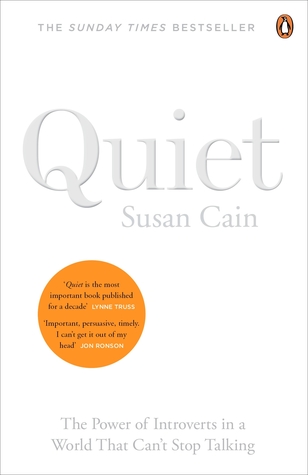 Susan Cain’s Quiet was a revelation to me when I discovered it. As a self-identifying introvert (an INTJ on the Myers-Briggs Type Indicator, if you’re curious), I learned that my personality type didn’t make me “weaker” than extroverts, nor was it something that should be stigmatised. Indeed, introverts have a number of superpowers which makes them better suited than extroverts in certain situations, if they can learn to recognise them.
Susan Cain’s Quiet was a revelation to me when I discovered it. As a self-identifying introvert (an INTJ on the Myers-Briggs Type Indicator, if you’re curious), I learned that my personality type didn’t make me “weaker” than extroverts, nor was it something that should be stigmatised. Indeed, introverts have a number of superpowers which makes them better suited than extroverts in certain situations, if they can learn to recognise them.
Introverts are often mislabelled as merely “shy”, but this isn’t accurate - they can excel in social situations, but they find extroversion draining and it needs to be balanced out with quiet, thoughtful time alone. This is something I definitely relate to when attending conferences: there’s real value to be gleaned from one-on-one conversations in the hallways, and the social functions are often the best part of the event, but after a certain point in an evening, I just need to be somewhere recharging on my own.
The continuum and the mistaken ideal
People aren’t either binary “introverted” or “extroverted”: we all exist on a continuum, where are energies are gained and recharged through differing activities, at differing rates, depending on where we sit. To counter the above, extroverted people begin to dry-up after too much time spent alone, and need to recharge by being in a busy environment (something which was particularly challenging to recreate during COVID lockdowns).
So much of our society is built to favour extroverts. In workplaces, the loudest voices tend to dominate. We shape our meetings and open-plan offices around putting everybody in the same place at the same time, and letting the group figure it out. Yet there are undoubtedly people in those scenarios who could excel if they were asked to contribute in a different fashion; for instance, they might identify valuable ideas during a project brainstorming session if they thought about the scenario alone for an hour, rather than trying to make their voices heard among the “groupthink” of boisterous voices which are comfortable with leading the conversation.
We see the same in our school systems, where quiet children are urged to “come out of their shell”, rather than being encouraged to embrace the learning which can occur during deep personal thought, and to share their thought processes with their louder peers. (Indeed, there’s an entire chapter in Quiet which is dedicated to nurturing quiet children, which I probably at-best skimmed when I first read the book in 2015, but which is much more relevant to me today.)
Can you (or should you) change?
Research shows that people can move beyond their inherited personality types, but only to a point; like a rubber band, we can stretch, but only so far:
“Free will can take us far […] but it cannot carry us infinitely beyond our genetic limits. Bill Gates is never going to be Bill Clinton, no matter how he polishes his social skills, and Bill Clinton can never be Bill Gates, no matter how much time he spends alone with a computer.”
When moving in either direction on the introversion-extroversion scale, our brain’s emotional centre (the amygdala) generates anxiety within the prefrontal cortex, effectively sending a message that we should return to a more comfortable state. That’s why we’re physically capable of stepping outside of our comfort zones, but that it’s often stressful to do so. Susan Cain shares her own experiences with this challenge: she didn’t enjoy public speaking, but knew that it would be a vital part of her work. Therefore she self-tailored her speaking engagements to make them less stressful, in ways that benefited her: for instance, by speaking about topics which she’s truly passionate about, allowing her to focus more on her passion for the topic, and less on the row of faces in front of her. Incidentally, her success with this technique is evident in her TED Talk, which is one of my all-time favourites:
Whichever direction you’re moving on the scale, there’s a “sweet spot” of “optimal stimulation” that’s valuable to seek out, as it’s where you can do your best work for the longest. Once you’re aware of this spot, you should seek to optimise both your home and working lives to create situations which allow you to retain your balance. For instance, an under-stimulated introvert might gain energy by meeting up with a friend for lunch, but this may turn into over-stimulation if several other friends turn up.
In summary: Be yourself.
“The trick is not to amass all the different kinds of available power, but to use well the kind you’ve been granted.”
Regardless of to what degree you see yourself as either introverted or extroverted, there’s little to be gained in the long-term from pretending to be something that you’re not. However, there’s real value in understanding what strengths your particular personality type offers you, what saps your energy, and your individual “restorative niches” which allow you to recover. For introverts, deep thought, focus and insight will always be critical in business settings, and it’s totally possible to shape a role which fits with your strengths.
We’re always eager to promote diversity and inclusivity within our organisations, but neurodiversity - particularly within latent personality types - is often under-measured, under-reported and under-managed. We should seek to build teams comprised of both introverts and extroverts, and design our workplaces to support them accordingly.
Key takeaways 📝
- Introversion isn’t a weakness, and nor is extroversion. Each requires different energies.
- Our workplaces are too often shaped to favour extroverts.
- Learn what makes you tick, what drains your energy, and what rejuvenates it.

